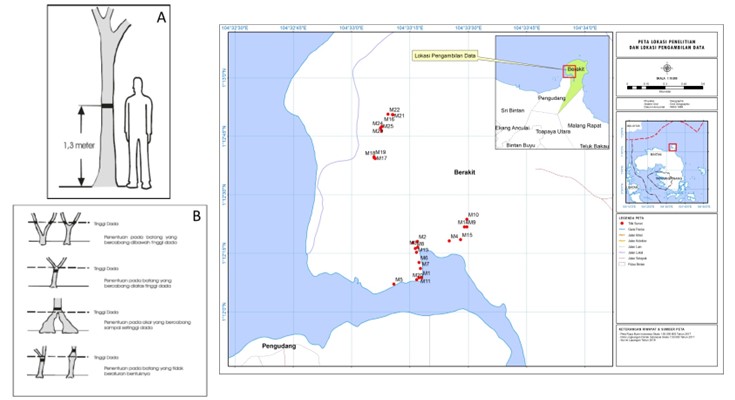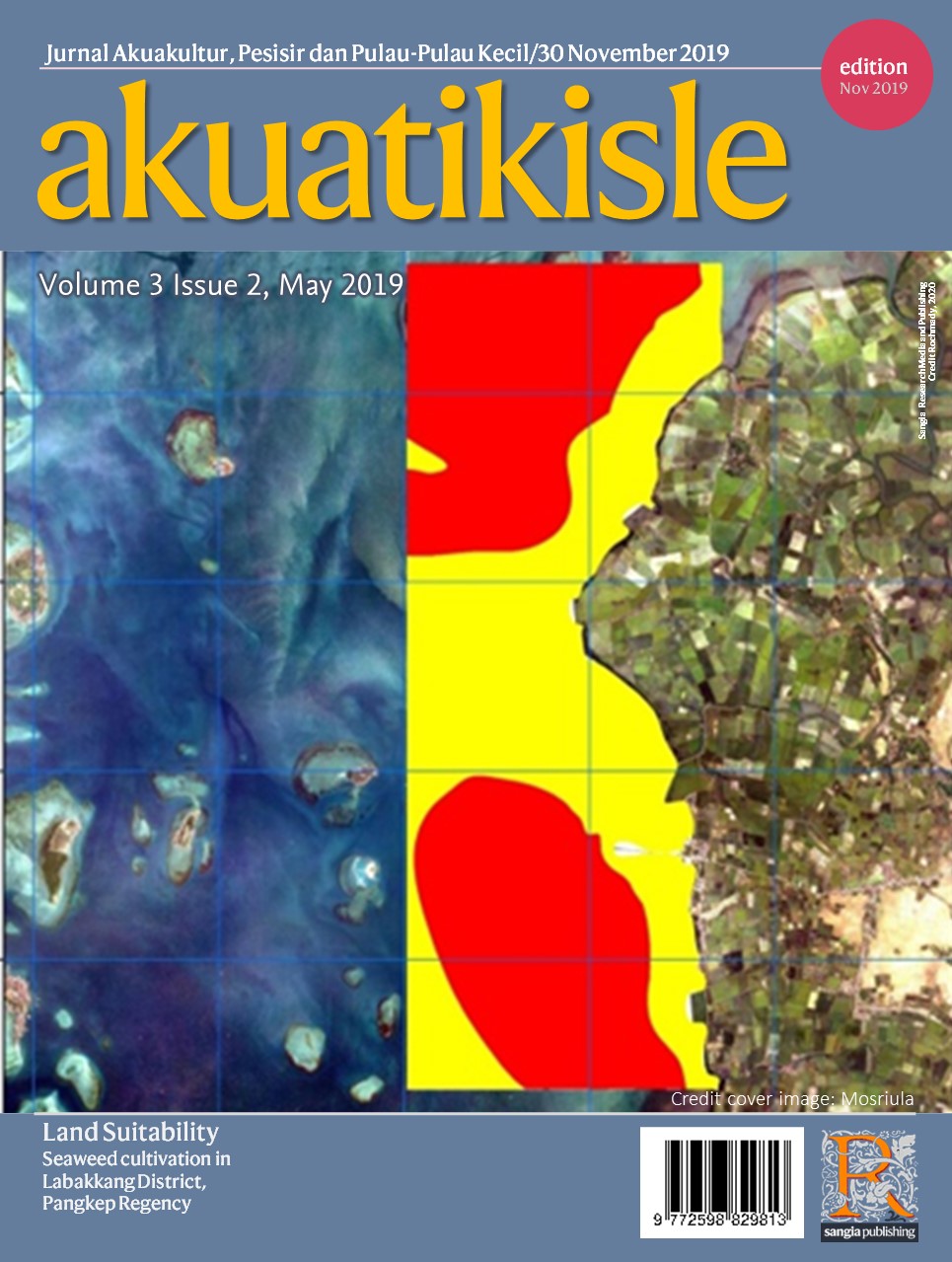Akuatikisle: Jurnal Akuakultur, Pesisir dan Pulau-Pulau Kecil
Full Length Article
Mangrove damage level in the waters of Berakit Village, Bintan Island, Indonesia
Highlights
Generate NLP AI by Wizdam ID.
Abstract
Mangrove forest or better known as mangrove forest is an ecosystem found in coastal waters and has an important ecological and economic role. This study aims to measure and determine the health status of mangrove forests that grow in the waters of Berakit, Bintan based on the level of tree density. The study was conducted in August to November 2019 which was conducted at twenty station points spread from the mainland to the coastal waters of Berakit. Field data collection was performed using the quadratic transect line method, 10x10 m2 plot was made along the transect line to measure the diameter of the tree at breast height (DBH) which has a trunk circumference for each mangrove tree at breast height of about 1.3 m. Mangrove health status based on the level of density of mangrove trees is included in the criteria of Good with Very Solid category. Rhizophora apiculata is a species of mangrove that grows well and has an important role in the waters of Berakit, Bintan island.
Keywords
Introduction
Section snippets
Material and Methods
Materials and methods from the full-text PDF of this article cannot be displayed.
Results
Results from the full-text PDF of this article cannot be displayed.
Discussion
Discussion from the full-text PDF of this article cannot be displayed.
Conclusions
Conclusions from the full-text PDF of this article cannot be displayed.
Acknowledgment
Acknowledgment from the full-text PDF of this article cannot be displayed.
Funding Information
Penelitian dibiayai Hibah PDP Penelitian Dikti, Kementerian Riset, Teknologi, dan Pendidikan Tinggi.
Competing interest
The authors declare that they have no known competing financial interests or personal relationships that could have appeared to influence the work reported in this paper.
Conflict of interest
The authors declare that the research was conducted in the absence of any commercial or financial relationships that could be construed as a potential conflict of interest.
Ethical approval acknowledgements
No ethical approval required for this article. All procedures followed were in accordance with the ethical standards of the responsible committee on human experimentation (institutional and national) and with the Helsinki Declaration of 1975, as revised in 2008 (5)
Supplementary files
Data sharing not applicable to this article as no datasets were generated or analysed during the current study, and/or contains supplementary material, which is available to authorized users.
References (1)
Alongi D.M., Murdiyarso D., Fourqurean J.W., Kauffman J.B., Hutahaean A., Crooks S., Lovelock C.E., Howard J., Herr D., Fortes M., Pidgeon E., & Wagey T., 2016. Indonesia’s blue carbon: a globally significant and vulnerable sink for seagrass and mangrove carbon. Wetlands Ecology and Management. 24(1):3–13. DOI: 10.1007/s11273-015-9446-y.
Bengen D.G., 2000. Pedoman Teknis Pengenalan & Pengelolaan Ekosistem Mangrove. Pusat Kajian Sumberdaya Pesisir dan Lautan (PKSPL), Institut Pertanian Bogor (IPB). Bogor.
Bornman E., Strydom N.A., & Wooldridge T.H., 2019. Predator-prey interactions associated with larval Gilchristella aestuaria (family clupeidae) in mangrove and non-mangrove estuaries. Estuarine, Coastal and Shelf Science. 228:106391. DOI: 10.1016/j.ecss.2019.106391.
Choong E.T., Wirakusumah R.S., & Achmadi S.S., 1990. Mangrove forest resources in Indonesia. Forest Ecology and Management. 33–34(C):45–57. DOI: 10.1016/0378-1127(90)90183-C.
Daru B.H., Yessoufou K., Mankga L.T., & Davies T.J., 2013. A Global Trend towards the Loss of Evolutionarily Unique Species in Mangrove Ecosystems. PLoS ONE. 8(6):e66686. DOI: 10.1371/journal.pone.0066686.
Dharmawan I.W.E., & Pramudji 2014. Panduan Monitoring Status Ekosistem Mangrove. COREMAP-CTI. Lembaga Ilmu Pengetahuan Indonesia. Jakarta, 35 p.
Donato D.C., Kauffman J.B., Murdiyarso D., Kurnianto S., Stidham M., & Kanninen M., 2011. Mangroves among the most carbon-rich forests in the tropics. Nature Geoscience. 4(5):293–297. DOI: 10.1038/ngeo1123.
Emata A.C., Eullaran B., & Bagarinao T.U., 1994. Induced spawning and early life description of the mangrove red snapper, Lutjanus argentimaculatus. Aquaculture. 121(4):381–387. DOI: 10.1016/0044-8486(94)90272-0.
Faridah-Hanum I., Yusoff F.M., Fitrianto A., Ainuddin N.A., Gandaseca S., Zaiton S., Norizah K., Nurhidayu S., Roslan M.K., Hakeem K.R., Shamsuddin I., Adnan I., Awang Noor A.G., Balqis A.R.S., Rhyma P.P., Siti Aminah I., Hilaluddin F., Fatin R., & Harun N.Z.N., 2019. Development of a comprehensive mangrove quality index (MQI) in Matang Mangrove: Assessing mangrove ecosystem health. Ecological Indicators. 102:103–117. DOI: 10.1016/j.ecolind.2019.02.030.
Giri C., Ochieng E., Tieszen L.L., Zhu Z., Singh A., Loveland T., Masek J., & Duke N., 2011. Status and distribution of mangrove forests of the world using earth observation satellite data. Global Ecology and Biogeography. 20(1):154–159. DOI: 10.1111/j.1466-8238.2010.00584.x.
Irawan S., Kurniawan D.E., Anurogo W., & Lubis M.Z., 2017. Mangrove Distribution in Riau Islands Using Remote Sensing Technology. Journal of Applied Geospatial Information. 1(2):58–62.
Jurn K., Lavallee J., & King L., 2018. Environmental destruction in the new economy: Offshore finance and mangrove forest clearance in Grand Cayman. Geoforum. 97:155–168. DOI: 10.1016/j.geoforum.2018.10.019.
KepMen LH 2004. Surat Keputusan Menteri Negara Lingkungan Hidup No 201 Tentang Kriteria Baku Dan Pedoman Penentuan Kerusakan Mangrove. No. 201, Indonesia.
Kozhikkodan Veettil B., & Quang N.X., 2019. Mangrove forests of Cambodia: Recent changes and future threats. Ocean and Coastal Management. 181:104895. DOI: 10.1016/j.ocecoaman.2019.104895.
Kuriandewa T.E., & Supriyadi I.H., 2006. Seagrass mapping in East Bintan coastal area, Riau Archipelago, Indonesia. Coastal marine science. 30(1):154–161.
Kusmana C., 1997. Metode Survey Vegetasi. IPB Press. Bogor, 9–17 p.
Kusmana C., 2014. Distribution and current status of mangrove forests in Indonesia. In: Mangrove Ecosystems of Asia: Status, Challenges and Management Strategies. Springer. pp. 37–60. DOI: 10.1007/978-1-4614-8582-7_3.
Masithah D., Kustanti A., & Hilmanto R., 2016. Nilai ekonomi komoditi hutan mangrove di desa Merak Belantung Kecamatan Kalianda Kabupaten Lampung Selatan. Jurnal Sylva Lestari. 4(1):69–80. DOI: 10.23960/jsl1469-80.
Mohanty B., Nayak A., Dash B., Rout S.S., Charan Kumar B., Patnaik L., Dev Roy M.K., Raman A., & Raut D., 2019. Biodiversity and ecological considerations of brachyuran crabs (Crustacea: Decapoda) from Devi estuary–mangrove region on the east coast of India. Regional Studies in Marine Science. 32:100865. DOI: 10.1016/j.rsma.2019.100865.
Mulyadi A., Yoswaty D., & Ilahi I., 2017. Dampak Lingkungan Dari Pengembangan Ekowisata Bahari Di Kawasan Konservasi Lamun Trikora,Bintan ,Kepulauan Riau. Berkala Perikanan Terubuk. 45(1):95–111.
Noor Y.R., Khazali M., & Suryadiputra I.N.N., 2006. Panduan Pengenalan Mangrove di Indonesia. Bogor. II ed., Wetlands Internasional Indonesia Programme. Bogor.
Nurkin B., 1994. Degradation of mangrove forests in South Sulawesi, Indonesia. Hydrobiologia. 285(1–3):271–276. DOI: 10.1007/BF00005673.
Rochmady R., 2015. Struktur dan komposisi jenis mangrove Desa Bonea dan Kodiri, Kabupaten Muna, Sulawesi Tenggara. In: Prosiding Simposium Nasional II Kelautan dan Perikanan. vol. 2. pp. 85–94. DOI: 10.2139/ssrn.3015165.
Saru A., 2013. Mengungkap Potensi Emas Hijau di Wilayah Pesisir. Masagena Pres. Makassar.
Soegiarto A., 1984. The mangrove ecosystem in Indonesia, its problems and management. In: Physiology and management of mangroves. Springer. pp. 69–78. DOI: 10.1007/978-94-009-6572-0_10.
Tuwo A., 2011. Pengelolaan Ekowisata Pesisir Dan Laut: Pendekatan Ekologi, Sosial-Ekonomi, Kelembagaan, dan Sarana Wilayah. Brilian internasional. Surabaya.
Ulfa M., Ikejima K., Poedjirahajoe E., Faida L.R.W., & Harahap M.M., 2018. Effects of mangrove rehabilitation on density of Scylla spp. (mud crabs) in Kuala Langsa, Aceh, Indonesia. Regional Studies in Marine Science. 24:296–302. DOI: 10.1016/j.rsma.2018.09.005.
Bibliographic Information
Cite this article as:
-
Submitted
20 November 2019 -
Revised
24 November 2019 -
Accepted
25 November 2019 -
Published
25 November 2019 -
Version of record
25 December 2019 -
Issue date
30 November 2019
-
Academic subject
Marine Sciences; Fisheries Sciences
Copyright
Sangia Advertisement
Copyright © 2019 Susiana, Mario Putra Suhana. Sangia Research Media and Publishing. Production and hosting by Sangia (SRM™).  This work is licensed under a Creative Commons Attribution-ShareAlike 4.0 International License.
This work is licensed under a Creative Commons Attribution-ShareAlike 4.0 International License.
Disclaimer: All claims expressed in this article are solely those of the authors and do not necessarily represent those of their affiliated organizations, or those of the publisher, the editors and the reviewers. Any product that may be evaluated in this article or claim that may be made by its manufacturer is not guaranteed or endorsed by the publisher.
Comments on this article
By submitting a comment you agree to abide by our Terms and Community Guidelines. If you find something abusive or that does not comply with our terms or guidelines please flag it as inappropriate.









